Deep Dive: into the burning heart of Earth
Glowing molten rock, just two kilometers beneath our feet: The world’s first magma observatory is being constructed in Iceland – with enormous potential for science, monitoring, and sustainable energy.
Glowing molten rock, just two kilometers beneath our feet: The world’s first magma observatory is being constructed in Iceland – with enormous potential for science, monitoring, and sustainable energy.
Magma bubbles away in the depths of the Earth, where heat and pressure cause rocks to melt – but under the Krafla volcanic field in northeastern Iceland, it comes surprisingly close to us. In the midst of this spectacular volcanic landscape, featuring black and brown lava fields with a azure-blue lake and low clouds from smoking fumaroles, engineers drilling for geotherm energy in 2009 intersected a 900°C magma chamber at a depth of just 2.1 kilometers. Three times the engineers attempted to complete their task – and three times the drill struck the glowing reservoir.
An eruption has not occurred for 3 decades, but the ground in Krafla remains palpably hot. The nearby Víti crater lake – the name is Icelandic for “hell” – was created during an explosive eruption in the 18th century. The most recent eruption series, known as the Krafla Fires, began in 1975 and lasted until 1984. Around the same time, the first drillings for the geothermal power plant started nearby. In the vicinity of the power plant, lava repeatedly flowed from several eruptive fissures, and on two occasions this runny magma used boreholes to reach the surface However, the viscous molten rock from the magma chamber drilled in 2009 did not erupt; instead they rose about ten meters within the narrow borehole before solidifying into volcanic glass upon contact with the cooled drilling fluid.
Researchers led by LMU volcanologist Yan Lavallée are now planning to exploit the unusual accessibility of the magma bubble. As anyone who has read the adventure novels of French author Jules Verne knows, the entrance to the center of the Earth is located beneath a volcano in Iceland. Although Verne was inspired by Snæfellsjökull and not Krafla, and even if the scientists do not intend to descend quite so far, Verne’s fantasy could nonetheless partially become reality: The Krafla Magma Testbed (KMT) project plans to create the world’s first magma observatory for accessing the Earth’s glowing interior. Lavallée is head of the science and technology committee for the project, which aims to drill, sample, monitor and utilize the magma this time around.
Yan Lavallée
How does magma behave deep in the crust? What happens in the transition zone to solid rock? And are there signs that could help us better predict looming volcanic eruptions? These are just some of the fundamental questions that this large geoscientific facility will seek to answer. The team also plans to investigate whether and under what conditions the magma can be used for geothermal energy. As magma contains significantly more energy than conventional geothermal sources, it would be, quite literally, a red-hot candidate for use as an energy source of the future.
The discovery of a shallow magma reservoir beneath Krafla is a stroke of luck for science, as there is no way to this day of locating magma with any certitude. Even in the well monitored Phlegraean Fields near Naples, the precise location of the magma chambers is not known. As regards Krafla, the 900°C magma holds other surprises apart from its accessibility. It is richer in silicates and thus more viscous than the lava from other eruptions in Krafla, with a dough-like consistency. As in all magmas, the main gas released from the bubble is water vapor, while it releases comparatively little of other gases like carbon dioxide (CO2), sulfur dioxide (SO2), and hydrogen sulfide (H2S). The relatively low gas content reduces the danger of explosive eruptions, when the release of pressure causes gases to shoot out – rather like carbon dioxide out of a shaken champagne bottle – pulling magma with them. Even in the uppermost, coolest area of the reservoir, there are barely any crystals – presumably there are convection currents in the interior that repeatedly draw crystallized minerals down where they melt, while hot melt flows up in their place.
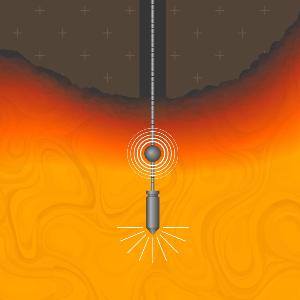
Sensor inside the magma. | © KMS-TEAM / LMU
Predicting volcanic eruptions is one of the big challenges of geoscience. “Currently, we always deploy our instruments at the surface of the Earth and can make only indirect inferences about processes in the depths,” says Lavallée. “But we need to take the pulse of the volcano directly.” KMT offers a unique opportunity to place probes inside magma and investigate its properties and dynamics in situ. In the course of the drilling, the researchers plan to take samples at regular intervals and install fiber optic cables and other sensors to record pressure, temperature, deformation and seismic activity in the rocks, all the way through to the magma itself.
The researchers expect that during drilling, magma will ascend a few meters into the borehole, as it did during the original accidental strikes, and solidify into volcanic glass. When the drilling is completed and they stop injecting cooling fluids, temperature will increase and cause the solidified magma to become molten again and flow around the sensors. “These sensors will help us better predict volcanic eruptions in the future,” says Lavallée. “How will a volcano erupt? Will it release a lava flow or cause a big explosive eruption? Will the eruption last five minutes or five years? Before now, we’ve been unable to estimate these details. Potentially, we could also develop methods for better interpreting the signals of our instruments at the surface.”
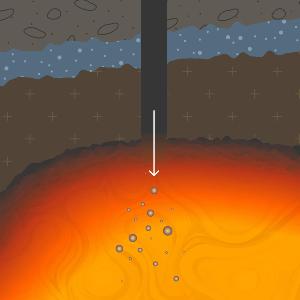
Experimental drilling. | © KMS-TEAM / LMU
In close proximity to the first borehole, a second one will be drilled as a portal for experiments during the second phase. Researchers will use this hole to do things like pump in or drain water and observe the consequences. Indeed, the boring itself is an experiment, as drilling causes pressure and temperature changes in the rock. Via the sensors in the first borehole, the researchers can record how the magma reacts. “It can crystallize, it can melt again, it can foam up,” says Lavallée. “We must understand how magma behaves and what signals it sends to the surface.”
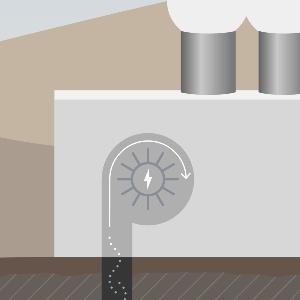
Geothermal power plant for electricity generation. | © KMS-TEAM / LMU
Geothermal technology utilizes the natural heat of the Earth to obtain energy. To date, this has mostly involved tapping underground geothermal water reservoirs, or else pumping cold water into hot rocks deep below the surface, where it is heated up. There are two basic geothermal approaches: low-energy geothermal systems with temperatures of around 25-60°C at depths of about 400 to 1,000 meters and hot geothermal systems in volcanic regions. The latter can reach temperatures of over 250°C, while the heat source – the magma – can reach 920°C at Krafla and higher temperature elsewhere. Near-surface geothermal energy is generally used only for heating or cooling purposes with the aid of heat pumps, whereas hotter geothermal fields are also used for heat distribution and electricity generation.
Due to the extensive volcanic activity in Iceland, the conditions for geothermal energy are particularly favorable. The country generates around a quarter of its electricity and about 90 percent of its heating from geothermal sources, through boreholes which deliver power of 5 MW on average. The hot water that circulates beneath the Krafla volcanic field is used by a geothermal power plant with an output of up to 60 MW. To this end, there are numerous boreholes from which steam is conveyed for power generation. The energy with which the steam shoots up varies from borehole to borehole and depends largely on the depth of the hole.

Magma as a heat source. | © KMS-TEAM / LMU
Extremely energy-rich, magma is the heat source that powers hydrothermal systems. “Why not go directly to the source?” asks Lavallée. Conventional deep geothermal systems use hot water from depths of 1-2 kilometers at temperatures between 80 and 200°C. If you drill near magma, you reach temperatures of over 900°C and pressures in excess of 220 bars (that is, more than 220 times normal air pressure). Under these conditions, water becomes supercritical – a state in which the boundary between fluid and gas becomes blurred – and shoots upward as a hot high-pressure fluid. Use of this medium could increase energy production tenfold.
But the researchers’ idea for the geothermal energy of the future is even more radical. They want to explore how to directly tap the red-hot mass from the depths – without the conventional circuitous route via geothermal fluids. Potential ways of achieving this, according to Lavallée, could be to use the volcanic gases as heat transfer media or to establish a circulatory system. “But perhaps it requires other revolutions – that is entirely new solutions.”
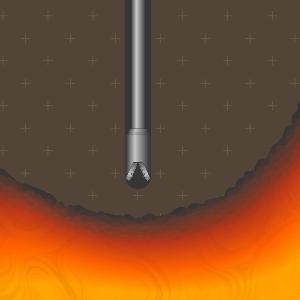
Drilling near the magma chamber. | © KMS-TEAM / LMU
Boring into an active volcano is not just virgin scientific territory, but also a major technical challenge. Since the project launched in 2017, the researchers have been working on suitable materials and methods, and boring is slated to begin in 2027 at the earliest. Before that, measuring instruments have to be developed that can withstand the extreme conditions inside an active volcano. On top of the high temperatures and pressures, there is the added difficulty that the water vapor in this environment contains many aggressive compounds. This includes sulfur, chlorine and fluorine compounds, which can form corrosive acids that attack steel rods, pipes, and the cement lining the borehole.
When the steam rises up, the pressure drops and silicates are precipitated, which intensifies the corrosion. As such, new alloys are needed. Moreover, the borehole has to be designed such as to remain stable over decades. The solution to these problems could even have effects beyond the Earth, as the conditions near the magma strongly resemble those on the planet Venus – and so KMT could open up new possibilities for testing materials for planetary missions.
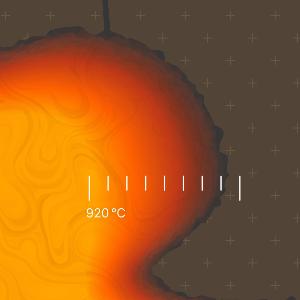
Between the magma and the rock, the temperature drops surprisingly rapidly. | © KMS-TEAM / LMU
The researchers are particularly interested in the transition zone between solid rock and liquid magma. In Krafla, they plan to collect samples across this boundary layer and from magma directly for the first time, in order to investigate magma properties and how it evolves and turns into rock through time. Initial experiments in the laboratory suggest that the temperature of magma is at ~920°C, whereas measurements in the well, 30 m above magma indicate temperature of just 400°C, marking a drastic drop.
Such a rapid fall indicates that large quantities of hot fluids transport the heat upward at extraordinary rates. This raises the question as to why magma remains liquid when heat is dissipated so quickly? The project has already yielded many surprising insights that call previous models into question. Lavallée is convinced: "Accessing magma via drilling will continue to radically transform our understanding of the Earth a necessity to improve our utilization of its resource."

Prof. Dr. Yan Lavallée | © privat
Yan Lavallée is Chair of Magmatic Petrology and Volcanology and Director of the Department of Earth and Environmental Sciences. His principal research interests are in understanding the behaviour of magmas and rocks, and their impact on volcanic, hydrothermal and geothermal systems.
Read more articles from LMU's research magazine in the online section and never miss an issue by activating the magazine alert!